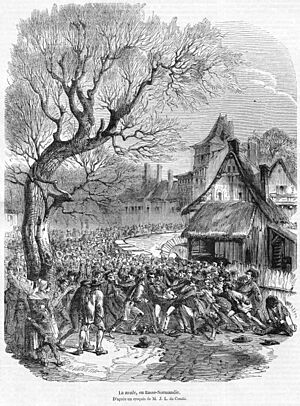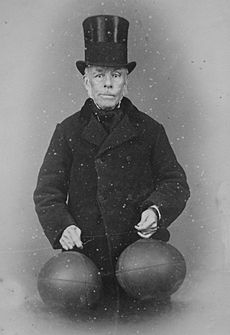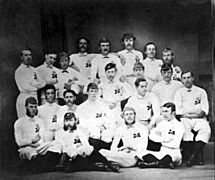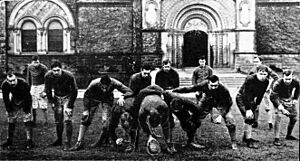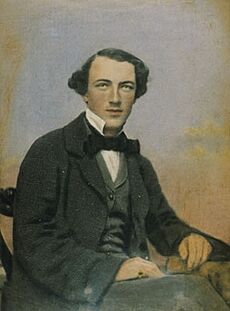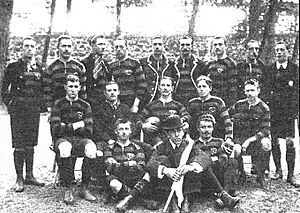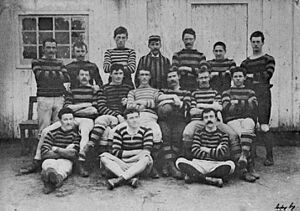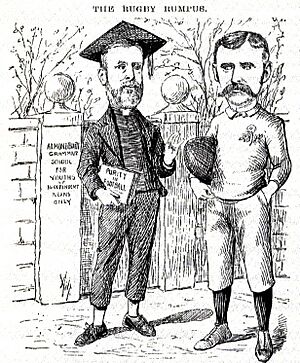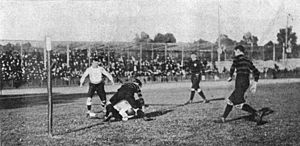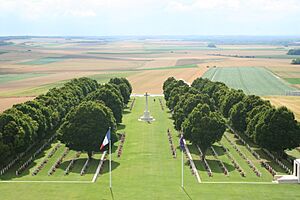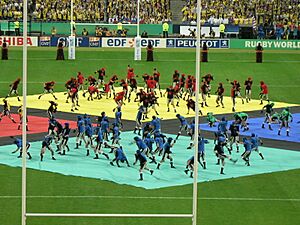History of rugby union facts for kids
Rugby union is a sport with a long and interesting past. It grew from different kinds of football games played centuries ago. But the rules we know today weren't written down until the mid-1800s. The game we call rugby union really started with three key moments: the first written rules in 1845, the Blackheath Club leaving the Football Association in 1863, and the creation of the Rugby Football Union in 1871.
At first, it was just called "rugby football". The name "rugby union" came about in 1895. This was after a big disagreement about whether players should be paid. This split led to a new sport called rugby league. For most of its history, rugby union was an amateur sport, meaning players weren't paid. But in 1995, that changed. Rugby union became an "open" game, allowing players to be professionals. This decision was made by the sport's main governing body, World Rugby, which was then known as the International Rugby Football Board (IRFB).
Contents
- Early Forms of Football
- Rugby's Beginnings in the 19th Century
- The Rugby Ball
- The Split with Association Football
- Forming the First Rugby Union
- First International Game
- Rugby Spreads Across the British Empire
- New Football Games and Rugby's Influence
- Rugby's International Growth
- Forming the International Rugby Football Board
- The Start of Rugby Sevens
- The Split Between Union and League
- 20th Century Rugby
- Rugby in the 21st Century
- How Scoring Changed
- When National Rugby Unions Were Formed
- Major International Rugby Competitions
- Rugby World Cup Finals
- Famous Rugby Games
- First International Games for Top Rugby Nations
- See also
Early Forms of Football
Long before modern rugby, people played many different kinds of football. The Romans played a game called harpastum, where teams fought to throw a large ball into a net. In medieval Ireland, people played caid, carrying an inflated bladder and using trees as goals. The Welsh played cnapan with a wooden ball. The French had soule, and Georgians played lelo burti.
Many of these old games, played across Europe and beyond, involved carrying the ball and forming groups like a scrum. For example, New Zealand had Ki-o-rahi, Australia had marn grook, and Japan had kemari.
The first detailed description of football in England was around 1174. William FitzStephen wrote about London youths playing a ball game on Shrove Tuesday. He said:
- After lunch all the youth of the city go out into the fields to take part in a ball game. The students of each school have their own ball; the workers from each city craft are also carrying their balls.
Many attempts were made to ban these football games, especially the wilder ones. In England, between 1324 and 1667, over 30 laws tried to stop football. But it was hard to enforce these bans because the games were so popular. King Edward II even banned it in London in 1314, saying it caused "great noise" and "many evils."
Some football games that allowed carrying the ball continued to be played. One such game, called Camping or Camp-ball, was played in East Anglia. It involved players carrying the ball and throwing it to teammates to move forward.
Rugby's Beginnings in the 19th Century

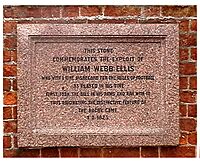
Football was played at Rugby School by 1803. By the 1830s, players could run with the ball, but they could also be tackled roughly. The school's students, not the teachers, made the rules, and they changed often.
The famous story of William Webb Ellis picking up the ball and running with it in 1823 is a legend. It first appeared in 1876, long after Webb Ellis had died. Historians now say it's likely not true. However, the trophy for the Rugby World Cup is still named the Webb Ellis Cup in his honor.
The Guy's Hospital Football Club, formed in London in 1843, is thought to be the world's first football club dedicated to rugby rules. Dublin University Football Club, founded in 1854, is arguably the oldest surviving football club of any type.
The Rugby Ball
Until the late 1860s, rugby balls were made of leather with a pig's bladder inside. This made them somewhat oval, but still much rounder than today's balls. A book called Tom Brown's Schooldays (written by someone who went to Rugby School) described the ball as "pointing towards the school goal," showing it wasn't perfectly round.
In 1851, a Rugby School football was shown at the first World's Fair in London. This ball, which is clearly oval, can still be seen today. In 1862, Richard Lindon started using rubber bladders. This made it possible to create balls with a more distinct oval shape. As handling the ball became more important than dribbling, the ball became flatter over time. In 1892, the RFU set official sizes for the ball. In the 1980s, leather balls were replaced with waterproof synthetic ones.
The Split with Association Football
The Football Association (FA) was formed in London in 1863. Its goal was to create one set of rules for all football games. However, there were disagreements, especially about two rules: "running with the ball" and "hacking" (kicking an opponent's shins).
At a meeting, Francis Maule Campbell of the Blackheath Club argued that hacking was a key part of football. He said removing it would take away the "courage and pluck" from the game. Because of these disagreements, Blackheath and other rugby clubs decided not to join the FA.
Forming the First Rugby Union
On December 4, 1870, Edwin Ash and Benjamin Burns wrote a letter suggesting that rugby-style clubs should meet to create common rules. On January 26, 1871, representatives from 21 clubs met in London.
This meeting led to the founding of the Rugby Football Union (RFU). Algernon Rutter became the first president. Three lawyers, who had attended Rugby School, wrote the first official laws of the game. These rules were approved in June 1871.
First International Game
The very first international rugby match happened because Scottish clubs challenged England. They invited a team "selected from the whole of England" to play a 20-a-side game under rugby rules. The game was played in Edinburgh, Scotland, on March 27, 1871.
This was not only the first international rugby match, but also the first international game of any kind of football. Even though some England vs. Scotland soccer games had been played before, FIFA doesn't count them as full internationals. This is because the Scottish players in those games were based in London, not truly from Scotland.
The English team wore white with a red rose, and the Scots wore brown with a thistle. Scotland won the game by scoring a goal after grounding the ball. Both teams also scored a "try" each, but couldn't convert them into goals. Angus Buchanan of Scotland scored the first try in international rugby. England won the return match in London in 1872.
Rugby Spreads Across the British Empire
Rugby football quickly spread to other countries, especially those connected to the British Empire.
In Australia, formal rugby started with the Sydney University Football Club in 1864. The first competition began in 1874.
In New Zealand, rugby was introduced in 1870 by Charles John Monro, who learned the game in England. The first match was played in Nelson. By the mid-1870s, rugby was popular throughout the country.
In South Africa, rugby began around 1875. William Henry Milton, a former England player, helped spread the game there. By the end of 1878, rugby had replaced other forms of football in Cape Town. However, for many years, rugby in South Africa was affected by racial segregation.
Early forms of rugby were played in Canada from the 1820s. The first recorded game of rugby in Canada was in Montreal in 1864. However, rugby in Canada soon faced strong competition from Canadian football.
New Football Games and Rugby's Influence
Rugby union wasn't the only football game around. In the late 1800s, new national football games appeared, like Australian rules football, Gaelic football (Ireland), and the gridiron games: American and Canadian football.
Some of these games were directly influenced by rugby. All of them involved kicking and carrying the ball towards goals. While American, Canadian, and Australian rules football became professional, Gaelic football remained amateur. The first three also use an oval-shaped ball, similar to a rugby ball.
Tom Wills, who started Australian rules football, went to Rugby School. He helped write the first rules for the Melbourne Football Club in 1859. He wanted rules that suited Australia's drier fields.
American football changed a lot from rugby starting in 1869. Walter Camp, known as the "Father of American Football," introduced new rules like the line of scrimmage and down-and-distance rules. Later, the forward pass and professionalism made American football even more different from rugby.
Michael Cusack, who helped found the Gaelic Athletic Association, was a rugby player in Ireland. He helped create the rules for Gaelic football in 1887. The GAA had a rule that stopped its properties from being used for sports like soccer and rugby, which they saw as rivals.
Rugby's International Growth
By the end of the 19th century, rugby football had spread widely, not just in the British Empire.
Rugby arrived early in Germany. The first German rugby team was at Neuenheim College in Heidelberg around 1850. The Heidelberger Ruderklub von 1872 (HRK 1872), founded in 1891, claims to be the oldest German rugby club.
In the United States, rugby-like games were played early on. By the 1840s, Harvard, Yale, and Princeton were playing rugby football. However, Yale banned it in 1862 for being too violent. In 1869, the first game of American football was played between Princeton and Rutgers, with rules very similar to rugby. But by 1882, Walter Camp's rule changes made American football distinct.
Rugby union also reached South America early. The first match in Argentina was in 1873. In 1890, a rugby game in Buenos Aires led to both teams and all 2,500 fans being arrested! The president was worried it was a political meeting. Rugby also reached Uruguay early, with the first certain match in 1880.
Rugby was likely the first non-native football game played in Russia in the 1880s. However, in 1886, Russian police stopped rugby, calling it "brutal" and likely to cause "riots."
Forming the International Rugby Football Board
In 1884, England had a disagreement with Scotland over a try. England felt they should have more power because they had more clubs. So, Scotland, Ireland, and Wales formed the International Rugby Football Board (IRFB) in 1886. England refused to join at first. The IRFB decided that member countries wouldn't play England until they joined and accepted the IRFB as the main rule-maker. England finally joined in 1890. In 1997, the IRFB moved its headquarters to Dublin and changed its name to the International Rugby Board (IRB). In 2014, it became World Rugby (WR).
How the Rules Changed
The rules of rugby have changed many times over the years, and they still do.
Number of Players
The number of players on each team was reduced from 20 to 15 in 1877.
Scoring Points
Historically, a "try" didn't give points directly. It just gave a team a chance to "try" to kick a goal. This is where the word "try" comes from. Before 1890, games were won by the number of goals scored. If it was a draw, then tries were counted.
Modern scoring was introduced in the late 1880s. A try was worth one point, and a successful kick after a try (a conversion) was worth two. Penalties and drop goals were worth three points. Over the years, the value of tries increased to encourage more attacking play. A try became worth three points in 1893, four in 1971, and five in 1992.
Penalties have been worth three points since 1891. Drop goals were worth four points for a while, but are now three. Rules about how penalty kicks and conversion kicks are taken have also changed to make the game fairer.
The Start of Rugby Sevens

Rugby sevens is a faster version of rugby with only seven players per team. It was created by Ned Haig and David Sanderson in 1883 as a way to raise money for a local club in Melrose, Scotland. The first sevens match was a big success.
Even though sevens was popular in the Scottish Borders, it didn't spread much until after World War I. The first sevens tournament outside Scotland was in England in 1921. In 1926, the major English tournament, the Middlesex Sevens, was started.
The Split Between Union and League
A big conflict arose over whether players should be paid for time off work to play. Many northern clubs had working-class players who lost money if they missed work for games. In 1892, some clubs were accused of professionalism for paying players for lost wages. The RFU worried this would lead to full professionalism.
On August 29, 1895, 20 clubs from northern England decided to leave the RFU. They formed the Northern Rugby Football Union, which later became the Rugby Football League. This split was about paying players. The RFU strictly enforced amateurism, banning anyone who took money or played rugby league. It took a century for rugby union to allow players to be paid.
20th Century Rugby
Rugby at the Summer Olympics
Pierre de Coubertin, who helped bring back the Olympic Games, included rugby union in the 1900 games in Paris. France won the gold medal. Rugby was also played at the 1908 games in London, where an Australian team won. The United States won the next two events, in 1920 and 1924, both times beating France. Even though rugby drew large crowds in 1924, it was removed from the Olympics after that.
In 2009, the International Olympic Committee voted to bring a form of rugby back to the Olympics. Rugby sevens was played for the first time at the Rio de Janeiro Olympics in 2016.
Early 1900s
Between 1905 and 1908, the three main Southern Hemisphere rugby countries—New Zealand, South Africa, and Australia—sent their first touring teams to the Northern Hemisphere. These teams brought new styles of play and were very successful. The New Zealand team in 1905 performed a haka (a traditional Maori dance) before each match. This led to the Welsh crowd singing their national anthem, Hen Wlad Fy Nhadau, for the first time at a sporting event. In 1905, France played England in its first international match.
World War I
The Five Nations Championship (a major European rugby tournament) was stopped in 1915 and didn't start again until 1920. Many international players were killed during World War I.
1920s
Rugby's Centenary
In 1923, people discussed celebrating 100 years since William Webb Ellis supposedly picked up the ball. A special match was planned at Rugby School to mark the occasion.
1930s
Forming FIRA
For many years, some suspected that the French Rugby Federation (FFR) was not following the rules about amateurism. In 1931, France was suspended from playing against other IRFB nations. Because of this, the Fédération Internationale de Rugby Amateur (FIRA) was founded in 1932.
FIRA was created to organize rugby union outside the IRFB's control. Its founding members included Italy, Romania, and the Netherlands. In the 1990s, FIRA recognized the IRB as the world governing body for rugby union. It later changed its name to FIRA – Association of European Rugby, and then to Rugby Europe in 2014. Rugby Europe has helped spread the sport beyond English-speaking countries.
Other Events in the 1930s
In 1931, Lord Bledisloe, the Governor-General of New Zealand, donated a trophy for games between Australia and New Zealand. This became the Bledisloe Cup, a famous rivalry in rugby.
After the French Rugby Federation was suspended in 1931, many French players switched to rugby league. Rugby league soon became very popular in France.
In 1939, the FFR was invited back to the Five Nations Championship, but World War II stopped international rugby. Many international rugby players died during the war.
World War II
During World War II, the RFU temporarily allowed rugby league players to play rugby union. They even held two "Rugby League vs. Rugby Union" matches to raise money for the war effort.
After France was defeated in 1940, the French Rugby Union worked with the government to make rugby union the main sport. Rugby league, being professional, was banned. Many rugby league players and officials were punished, and their assets were given to the rugby union. This still affects rugby league in France today.
After the War: 1940s and 1950s
In 1947, the Five Nations Championship started again with France included. In 1948, the value of a drop goal was reduced from 4 points to 3. In 1949, the Australian Rugby Union was formed to manage the game in Australia.
1960s
In the 1960s, there was growing criticism of the racist apartheid system in South Africa. This racism affected rugby union, leading to big controversies. By 1969, groups like "Halt All Racist Tours" were formed in New Zealand to protest tours by South African teams.
1970s
In 1970, mini rugby was invented, a simpler version of the game used to teach children. In 1971, Scotland appointed its first head coach, Bill Dickinson, after years of avoiding it because they believed rugby should remain amateur. The 1971 Springbok tour to Australia saw many political protests against South Africa's apartheid system. The 1970s were a great time for Wales, as their team won many Five Nations titles. In 1975, the United States of America Rugby Football Union (now USA Rugby) was formed.
1980s
The 1981 Springbok Tour to New Zealand also had many political protests. It divided New Zealand society and hurt rugby's image. This image was not fully restored until New Zealand won the first 1987 Rugby World Cup. In 1983, the Women's Rugby Football Union (WRFU) was formed, managing women's rugby in England, Wales, Scotland, and Ireland. In 1984, the Wallabies achieved their first grand slam, beating all four British and Irish teams.
The Rugby World Cup
The first Rugby World Cup was held in 1987 in New Zealand and Australia. The All Blacks (New Zealand) beat France in the final. In 1991, England hosted the second tournament, but Australia won.
The 1995 World Cup was a major turning point. It was held in South Africa, which had just rejoined international sports after the end of apartheid. The Springboks won the final, beating the All Blacks. South African President Nelson Mandela, wearing a Springbok jersey, presented the trophy. This moment became a symbol of unity for the new South Africa.
Australia won the 1999 Rugby World Cup, held in Wales. They beat France in the final. In 2003, Australia hosted again but lost to England in a very close final, decided by a last-minute drop goal from Jonny Wilkinson.
France hosted the 2007 Rugby World Cup. The Argentine Pumas surprised everyone by finishing third. This led to calls for Argentina to join a major international competition. They eventually joined the Tri Nations in 2012, which was then renamed The Rugby Championship.
Rugby Union and Apartheid
Even before apartheid laws were passed in South Africa, touring sports teams often excluded non-white players. For example, in 1906, South Africans objected to a black English player.
After 1960, the Springboks became a target for protests against apartheid.
| Date | Event |
|---|---|
| 1960 | An All Blacks team with no Maori players toured South Africa, despite protests. |
| 1969 | Large anti-apartheid protests happened during the Springbok tour of Great Britain and Ireland. Many matches were played behind barbed wire fences. |
| 1971 | The Springbok tour of Australia was marked by protests. |
| 1976 | Many nations boycotted the 1976 Summer Olympics because New Zealand was not banned for playing against South Africa. |
| 1981 | The 1981 tour of New Zealand caused huge public disruption and divided the country. |
| 1985 | A planned All Black tour of South Africa was stopped by a court. A "rebel" tour by a team called the Cavaliers happened the next year. |
| 1989 | A World XV team, approved by the International Rugby Board, toured South Africa. |
Professionalism in Rugby
On August 26, 1995, World Rugby declared rugby union an "open" game. This meant players could finally be paid. This decision was made to stop the "shamateurism" (players being paid secretly) and keep control of the sport.
In Australia, a rival rugby league competition was offering big salaries, threatening to take rugby union players. To counter this, SANZAAR was formed in 1995 by the New Zealand, Australian, and South African Rugby Unions. SANZAR created a new professional competition called Super 12 (later Super Rugby) and an annual Test match competition called the Tri Nations Series. They secured a huge TV deal with Rupert Murdoch's News Corporation.
The Heineken Cup was also formed in 1995 for European clubs. It grew to include teams from all Six Nations countries.
Professionalism helped rugby union in Italy. Italian leagues attracted money and good coaches and players. This led to their national team being able to compete with top European teams. Italy joined the main European tournament, which became the Six Nations Championship in 2000.
A key benefit of professionalism was stopping rugby union players from leaving for rugby league for money. However, the two sports have become quite different in culture and play style.
Rugby in the 21st Century

Some changes to rugby union rules were tested in South Africa in 2006. About half of these changes were later made permanent to make the game easier to understand.
In 2012, the Tri Nations competition expanded to include Argentina and was renamed The Rugby Championship. Super Rugby also expanded, adding teams from Argentina and Japan.
In 2014, the European club competitions were changed. The top competition, the Heineken Cup, was replaced by the European Rugby Champions Cup.
Recent years have seen big changes in international club rugby. South Africa's major club teams moved away from Super Rugby and joined the European club system. They now play in the United Rugby Championship with teams from Ireland, Scotland, and Wales. Super Rugby itself was rebranded as Super Rugby Pacific in 2022, with teams from Australia, New Zealand, Fiji, and other Pacific islands.
How Scoring Changed
The scoring system in rugby has changed many times. At first, completing a "touch down" just gave a team a chance to "try" to kick a goal. This is why it's called a "try." Before 1890, games were won by the number of goals scored.
The International Rugby Football Board introduced a standard scoring system in 1886. A try was worth 1 point, a conversion 2 points, and a drop goal or penalty goal 3 points. Most changes since then have increased the value of tries compared to kicks, to encourage more attacking play.
| Date | Try | Conversion | Penalty | Dropped goal | Goal from mark | Notes |
|---|---|---|---|---|---|---|
| 1871–1875 | no score | 1 goal | 1 goal | 1 goal | N/A | Rules from the RFU before the IRFB was formed. |
| Match won by scoring more goals | ||||||
| 1876–1885 | 1 try | 1 goal | 1 goal | 1 goal | N/A | |
| Match won by more goals, or if goals are equal, by more tries | ||||||
| 1886–1891 | 1 point | 2 points | 3 points | 3 points | N/A | Scoring systems after the IRFB (now World Rugby) took over. |
| 1891–1894 | 2 points | 3 points | 3 points | 4 points | 4 points | |
| 1894–1904 | 3 points | 2 points | 3 points | 4 points | 4 points | |
| 1905–1947 | 3 points | 2 points | 3 points | 4 points | 3 points | |
| 1948–1970 | 3 points | 2 points | 3 points | 3 points | 3 points | |
| 1971–1977 | 4 points | 2 points | 3 points | 3 points | 3 points | |
| 1977–1991 | 4 points | 2 points | 3 points | 3 points | N/A | |
| 1992–present | 5 points | 2 points | 3 points | 3 points | N/A | |
When National Rugby Unions Were Formed
The first national rugby union was the Rugby Football Union in England, founded in 1871. Then came Scotland (1873), Ireland (1879), and Wales (1881). France formed its federation in 1919, and Italy, a more recent addition to the Six Nations, in 1928.
In the Southern Hemisphere, South Africa and New Zealand formed their unions before the end of the 1800s. In Australia, unions were formed in New South Wales (1874) and Queensland (1883), which later helped create the Australian Rugby Union (now Rugby Australia) in 1949. Argentina's union was founded in 1899.
Other important unions formed include Fiji (1913), Tonga (1923), Samoa (1923), Japan (1926), Canada (1965), and USA (1975). Many other governing bodies have been set up more recently around the world.
Major International Rugby Competitions
- 1883: First Home Nations Championship (England, Ireland, Scotland, Wales).
- 1900: Rugby union was part of the Olympics until 1924.
- 1910: The Home Nations Championship became the Five Nations Championship when France joined.
- 1951: The South American Rugby Championship began.
- 1987: The first Rugby World Cup was held.
- 1991: The first Women's Rugby World Cup took place.
- 1996: The Tri Nations Series started with Australia, New Zealand, and South Africa.
- 2000: The Five Nations became the Six Nations Championship when Italy joined.
- 2012: The Tri Nations added Argentina and was renamed The Rugby Championship.
- 2016: The first Olympic sevens tournaments were held.
Rugby World Cup Finals
For more details see the article Rugby World Cup
- 1987: New Zealand beat France 29–9 in New Zealand.
- 1991: Australia beat England 12–6 in London.
- 1995: South Africa beat New Zealand 15–12 in Johannesburg.
- 1999: Australia beat France 35–12 in Cardiff.
- 2003: England beat Australia 20–17 in Sydney.
- 2007: South Africa beat England 15–6 in France.
- 2011: New Zealand beat France 8–7 in New Zealand.
- 2015: New Zealand beat Australia 34–17 in London.
- 2019: South Africa beat England 32–12 in Japan.
- 2023: South Africa beat New Zealand 12–11 in France.
Famous Rugby Games
- 1871: The first official international match, between England and Scotland.
- 1905: Wales narrowly beat the first touring New Zealand team, called 'The Game of the Century'.
- 1973: The Barbarians beat the All Blacks in Cardiff.
- 1978: Irish team Munster beat the All Blacks 12–0. This was the All Blacks' only loss on their 1978 tour.
- 1999: France surprisingly beat the favored All Blacks in the Rugby World Cup semi-finals.
- 2000: New Zealand narrowly beat Australia in front of a record crowd of 109,874.
First International Games for Top Rugby Nations
- 1871: Scotland and England.
- 1875: Ireland.
- 1881: Wales.
- 1891: South Africa.
- 1899: Australia.
- 1903: New Zealand.
- 1906: France.
- 1910: Argentina.
- 1912: United States.
- 1919: Romania.
- 1924: Samoa, Fiji, and Tonga.
- 1929: Italy.
- 1932: Canada and Japan.
- 1989: Georgia.
See also
 In Spanish: Historia del rugby para niños
In Spanish: Historia del rugby para niños
- England v Scotland representative football matches (1870–1872)
- List of oldest rugby union competitions
- McGill University


